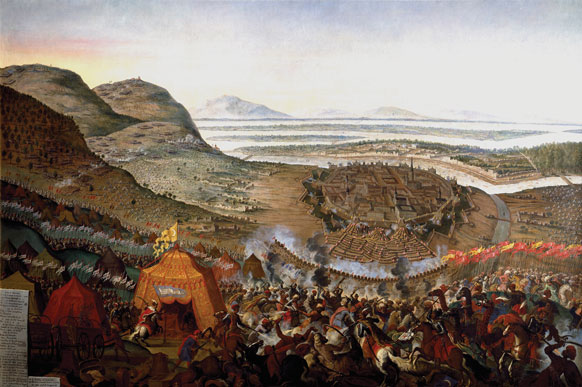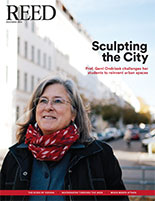
IRIS login | Reed College home Volume 94, No. 4: December 2015
Tales of the Thesis Tower
Disaster on the Danube

The Battle of Kahlenberg, 1683 by Frans Geffels. Polish horsemen descend upon the Ottoman forces besieging Vienna. The Janissaries were not called out of the trenches until it was too late.
The fate of Europe hung in the balance when the Ottoman army besieged Vienna in 1683
By Rick Peterson ’15
On a bright spring day in 1682, Mehmed IV, the Sultan of the Ottoman Empire, raised his banners, the seven ancient horsetail tūg of the House of Osman, in front of the Tokapi palace in Istanbul, and massed a gargantuan army: formidable Janissaries, cavalry from Egypt, infantry from Bosnia, Tatar scouts from the Crimea, plus specialized units dedicated to artillery, mining, tent-pitching, and even breadmaking. Marching across the Hungarian plain, along with herds of sheep and camels, the vast Ottoman force was united by a single goal—the conquest of Vienna and the destruction of the Hapsburg Empire.
The campaign that is often referred to as the “Siege of Vienna” (a more accurate title would be the “Second Ottoman Siege of Vienna”) was really all about ego. On one side was the Imperial House of Osman, which claimed descent from Noah and to be the rightful inheritors of the Roman Empire. On the other side was the Imperial House of Hapsburg, which also claimed descent from Noah and the title of Holy Roman Empire. Their rival claims to the throne of Rome, as well as the proximity of their empires, had led to generations of warfare.
Mehmed, who had acquired a reputation for laziness and hedonism (his appellation was “The Hunter”), desperately wanted to be seen as a great Sultan such as Mehmed II (who took Constantinople) and Suleiman the Magnificent (who launched the unsuccessful First Ottoman Siege of Vienna). The Hapsburg Emperor, in contrast, was the bookish Leopold, who had trained to be a priest. He was not considered a particularly effective leader by many contemporaries, but he saw himself as a bastion of Christendom besieged by an army of heathens.
Perhaps the biggest ego of all, however, belonged to the Ottoman Grand Vizier, Kara Mustafa. Kara Mustafa was an adopted son of the legendary Köprülü political dynasty; the Köprülüs had rescued the empire from the brink of collapse when Mehmed was still a child and enlarged the powers of the Grand Vizier so greatly that they, not the Sultan, effectively ruled the empire. Kara Mustafa was especially ambitious; to this day, many historians believe he intended to usurp the throne or carve out his own kingdom.
Vienna—known to the Turks as the “Golden Apple”—must have seemed like over-ripe fruit in 1682. That year, Protestant Hungarians under Count Imre Tekeli rebelled against the repression of their Catholic Hapsburg overlords and sought protection from the Ottomans. Thanks to this uprising, the Ottomans now had allies inside Hapsburg territory, ready to deliver them to the gates of Vienna—and all that lay beyond it.
Going into my senior year, I had originally intended to write my thesis about the American war in Vietnam, but by the time I submitted my ideas to the history department (at the last possible moment), there were no more experts on American history left to advise me. I turned to my fall-back topic, a vague idea about Istanbul in the Early Modern period. During my first meeting with Prof. David Garrett [history 1998–], we dismissed that topic and started exploring new ones. At one point, he asked, “What is so fascinating about the Ottomans of this period to you?” Basically, I wanted to know why the Ottomans had given up on the dream of ruling the Mediterranean world. After some research, I decided to focus on the siege of Vienna. Also, I wanted to find out if that was really where and when the croissant was invented (it was not).
All told, the Ottoman force numbered an astonishing 200,000 men—almost ten times the strength of the Hapsburg armies. The Ottomans swept across the vast Hungarian plain and approached Vienna from the southeast. Leopold, believing it was merely a border incursion, did not evacuate the royal family (or the royal silverware) until the dust cloud of the invaders darkened the horizon. The Ottomans arrived to find the city’s suburbs on fire (which helped conceal their movements from Hapsburg artillery) and immediately started digging siege works.
Common sense dictated that a second line of works also be built, this one facing outwards, to protect the besieging army from counterattack. But for some reason, Kara Mustafa did not do this. For the next two months, he wasted the Janissaries—arguably the best infantrymen in the world at the time—in penny-packet attacks on breaches in Vienna’s fortifications made by his artillery and mines, typically for little to no gain.
Meanwhile, conditions inside the city were growing desperate. A form of dysentery known as the “red flux” sickened thousands of Viennese. Stocks of food and water were dwindling fast. The Ottomans fired mortars and arrows into the city, sending silent death arcing over the defenses every night. Leopold pleaded for help from his European allies, but assurances were vague and timetables uncertain.
Historians often invoke grand technological and economic forces to explain why wars are won or lost. But the fate of Vienna often seems to have hinged on minor details, such as the defense of a ruined ravelin (a type of v-shaped, free standing earth work) that lasted three days longer than the Hapsburgs had dared to hope, or the moment when an Ottoman mine breached the main wall at its most vulnerable point—just as the Hapsburgs were changing guard, so the Janissary assault wave ran right into a double dose of musket fire and were ripped apart on their new “ramp.” The stalemate took its toll on Ottoman morale. The soldiers stopped maintaining the sanitary discipline that had been one of their hallmarks; soon disease was spreading throughout the corpse-choked trenches.
On September 12, Leopold’s reinforcements finally arrived. Led by Polish King Jan Sobieski, Polish horsemen—the famous winged hussars—seized the Kahlenburg heights over the city. As Kara Mustafa tried to shift troops to deal with them, a confused fight in the hinterlands turned into an Ottoman rout. The Janissary battalions were not ordered out of their trenches until far too late, leading to more needless losses, and many miners were trapped in their tunnels as the Poles and Hapsburgs swept through the trenches. The Ottomans’ great gambit had turned to disaster.
Kara Mustafa was executed on Christmas day for his failure. This did not end the war, however; smelling blood, the victorious Europeans formed a “Holy League” and counterattacked the Ottomans. An incompetent series of Grand Viziers oversaw battlefield defeats, which led to mutiny and political upheaval. The power of the Sultanate was weakened, and the Janissary corps—the heart of the Ottoman war machine—was gutted. After 17 years of bitter conflict, the Ottomans signed the humiliating Treaty of Karlowitz, conceding many territories in Europe and the Mediterranean. The daring strike against Vienna had backfired more completely than perhaps any other military operation in history. Instead of revitalizing their empire, Mehmed and Kara Mustafa had sealed its fate.

LATEST COMMENTS
steve-jobs-1976 I knew Steve Jobs when he was on the second floor of Quincy. (Fall...
Utnapishtim - 2 weeks ago
Prof. Mason Drukman [political science 1964–70] This is gold, pure gold. God bless, Prof. Drukman.
puredog - 1 month ago
virginia-davis-1965 Such a good friend & compatriot in the day of Satyricon...
czarchasm - 4 months ago
John Peara Baba 1990 John died of a broken heart from losing his mom and then his...
kodachrome - 7 months ago
Carol Sawyer 1962 Who wrote this obit? I'm writing something about Carol Sawyer...
MsLaurie Pepper - 8 months ago
William W. Wissman MAT 1969 ...and THREE sisters. Sabra, the oldest, Mary, the middle, and...
riclf - 10 months ago